PONTIAC PONTIAC 1996 Manual Online
Manufacturer: PONTIAC, Model Year: 1996, Model line: PONTIAC, Model: PONTIAC PONTIAC 1996Pages: 370, PDF Size: 17.69 MB
Page 81 of 370
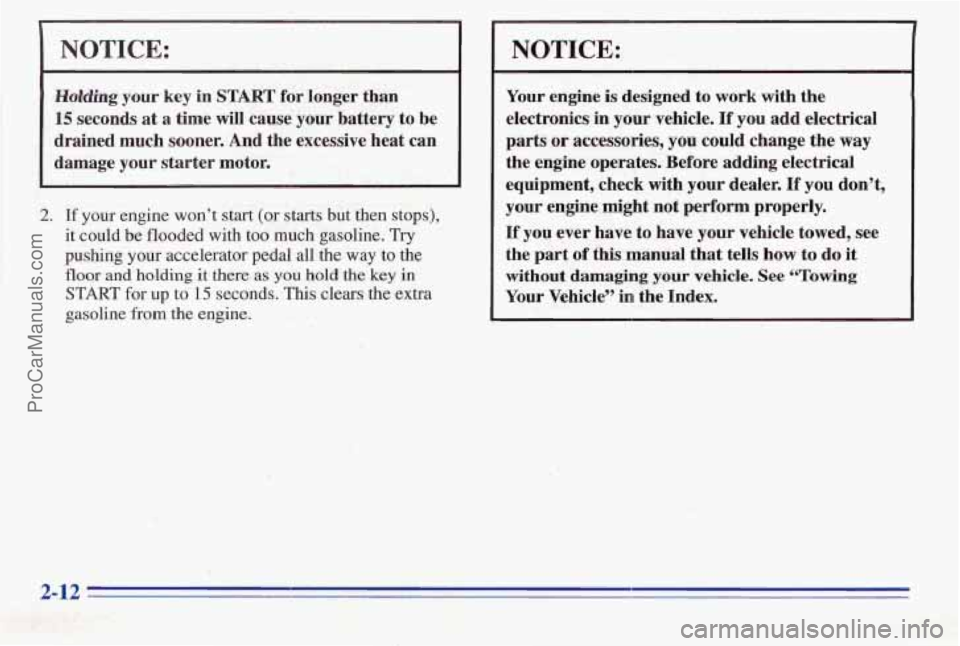
NOTICE:
Hdding your key in START for longer than
15 seconds at a time will cause your battery to be
drained much sooner. And the excessive heat can
damage your starter motor.
2. If your engine won’t start (or starts but then stops),
it could be flooded with too
much gasoline. Try
pushing your accelerator pedal all the way to the
floor and holding it there as you hold the key in
START for up to 15 seconds. This clears the extra
gasoline from the engine.
4
NOTICE:
Your engine is designed to work with the
electronics in your vehicle.
If you add electrical
parts
or accessories, you could change the way
the engine operates. Before adding electrical
equipment, check with
your dealer. If you don’t,
your engine might not perform properly.
If’ you ever have to have your vehicle towed, see
the part
of this manual that tells how to do it
without damaging your vehicle. See “Towing
Your Vehicle” in the Index.
2-12
ProCarManuals.com
Page 82 of 370
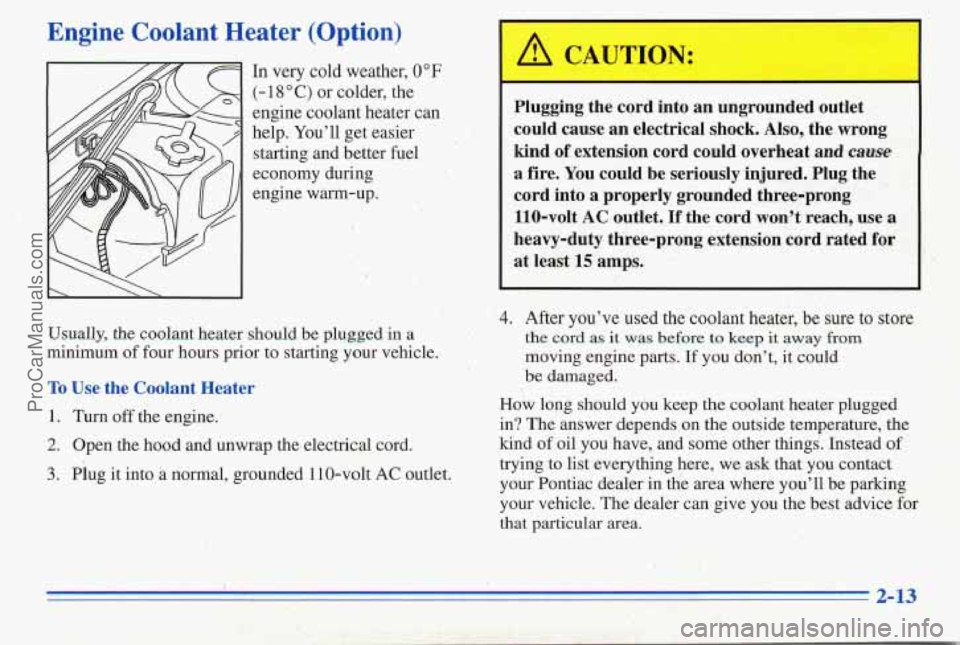
Engine Coolant Heater (Option)
In very cold weather, 0" F
(- 18 O C) or colder, the
engine coolant heater can
help. You'll get easier
starting and better fuel
economy during
engine warm-up.
A I
I A CAUTION: I
Plugging the cord into an ungrounded outlet
could cause an electrical shock. Also, the wrong
kind
of extension cord could overheat and cause
a fire. You could be seriously injured. Plug the
cord into a properly grounded three-prong 110-volt AC outlet.
If the cord won't reach, use a
heavy-duty three-prong extension cord rated for
I at least 15 amps.
4. After you've used the coolant heater, be sure to store
Usually, the coolant heater should be plugged in a the cord as it was before to keep it away from
minimum of four hours prior to starting your vehicle. moving engine parts. If you don't, it could
' - be damaged. To Use the- Coolant Heater
How long should you keep the coolant heater plugged
1. Turn off the engine.
in? The answer depends on the outside temperature, the
2. Open the hood and unwrap the electrical cord. kind of oil you have, and some other things. Instead of
.. - .. ' . ':. 1 :\'. . . .. .
~ ~
3. Plug it into a normal, grounded 110-volt AC outlet. trying to list
everything here, we ask that you contact
your Pontiac dealer in tlie area where you'll be parking
your vehicle. The dealer can give you-the best advice for
that particular area,
ProCarManuals.com
Page 83 of 370
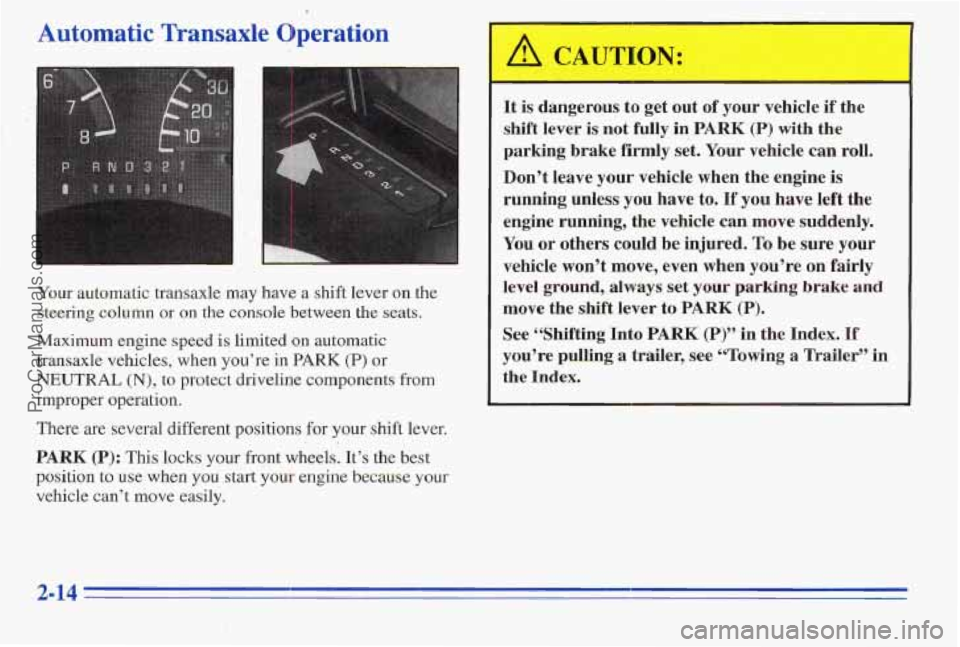
Automatic Transaxle Operation
Yom automatic transaxle may have a shift lever on the
steering
column or on the console between the seats.
Maximum engine speed is limited
on automatic
transaxle vehicles, when you’re in
PARK (P) or
NEUTRAL (N), to protect driveline components from
improper operation.
There are several different positions for your shift lever.
PARK (P): This locks your front wheels. It’s the best
position to use when you start your engine because your
vehicle can’t move easily.
/I CAUTION:
It is dangerous to get out of your vehicle if the
shift lever is not
fully in PARK (P) with the
parking brake firmly set. Your vehicle can roll.
Don’t leave
your vehicle when the engine is
running unless you have to. If you have left the
engine
running, the vehicle can move suddenly.
You or others could
be injured. To be sure your
vehicle won’t move, even when you’re on fairly
level ground,
always set your parking brake and
move the shift lever to PARK (P).
See “Shifting Into PARK (P)” in the Index. If
you’re pulling a trailer, see LCTo~ing a Trailer” in
the Index.
ProCarManuals.com
Page 84 of 370
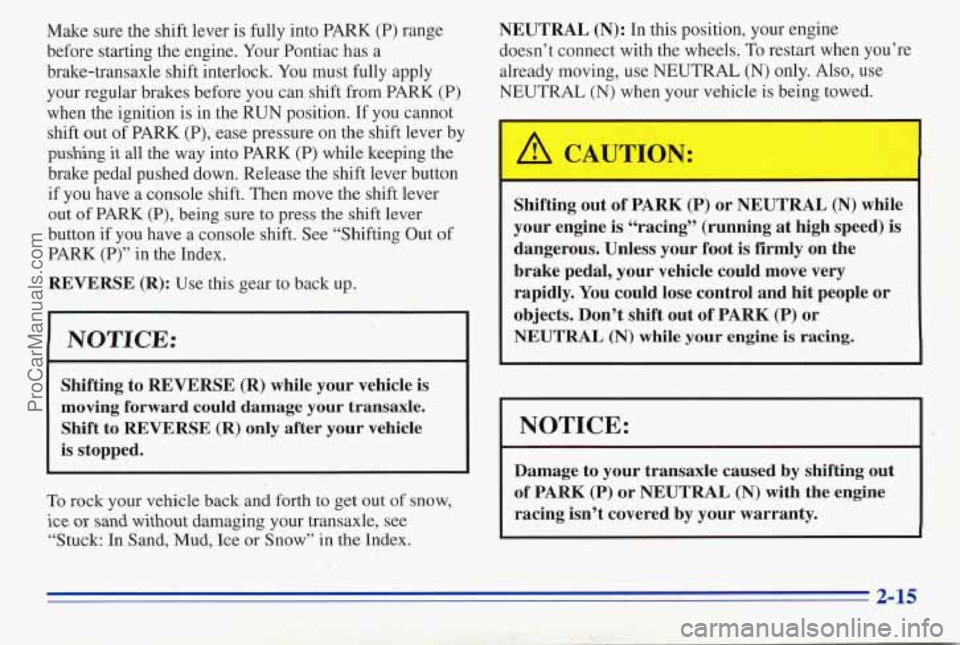
Make sure the shift lever is fully into PARK (P) range
before starting the engine. Your Pontiac has a
brake-transaxle shift interlock. You must fully apply
your regular brakes. before you can shift from PARK (P)
when the ignition is in the RUN position. If you cannot
shift out of PARK (P), ease pressure on the shift lever by
pushing it all the way into PARK (P) while keeping the
brake pedal pushed down. Release the shift lever button
if you have a console shift. Then move
the shift lever
out of PARK
(P), being sure to press the shift lever
button if you have a console shift. See “Shifting Out
of
PARK (P)” in the Index.
REVERSE (R): Use this gear to back up.
NOTICE:
.. .. ‘9: -. ~. - , . .. I. .,, :- . *.
Shifting to REVERSE (R) while your vehicle is
moving
forward could damage your transaxle.
Shift to REVERSE
(R) only after your vehicle
is stopped.
To rock your vehicle back and forth to get out of snow,
ice or sand without damaging your transaxle, see
“Stuck: In Sand,
Mud, Ice or Snow” in the Index.
NEUTRAL (N): In this position, your engine
doesn’t connect with the wheels. To restart when you’re
already moving, use NEUTRAL (N) only. Also, use
NEUTRAL (N) when your vehicle is being towed.
Shifting out of PARK (P) or NEUTRAL (N) while
your engine is “racing” (running
at high speed) is
dangerous. Unless your foot is firmly on the
brake pedal, your vehicle could move very
rapidly. You could lose control and hit people or
objects. Don’t shift out
of PARK (P) or
NEUTRAL (N) while your engine is racing.
NOTICE:
Damage,to your transaxle caused by shifting out
of PARK (P) or NEUTRAL (N) with the engine
racing isn’t covered by your warranty.
2-15
ProCarManuals.com
Page 85 of 370
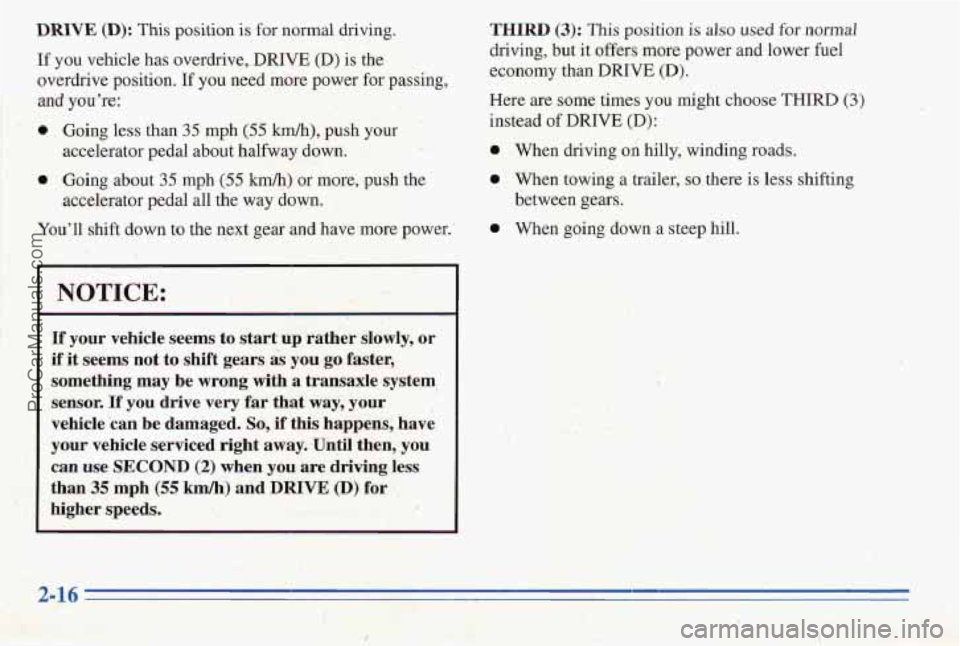
DRIVE (D): This position is for normal driving.
If you vehicle has overdrive, DRIVE (D) is the
overdrive position. If you need more power for passing,
0 Going less than 35 mph (55 km/h), push your
0 Going about 35 mph (55 kmk) or more, push the
You'll shift down to the next
gear and have more power.'
and you":
accelerator pedal about halfway down.
accelerator pedal all the way down.
THIRD (3): This position is also used for normal
driving, but
it offers more power and lower fuel
economy than
DRIVE (D).
Here are some times you might choose THIRD (3)
instead of DRIVE (D):
0 . When driving on hilly, winding roads.
0 When towing a trailer, so there is less shifting
0 When going down a steep hill.
between gears.
NOTICE:
'If your vehicle seems to startup rather slowly, or
if it seems
not to.sMft gears is you go faster,
something may be wrong with
a transaxle system
,sensor. If you drive very far that way, your
vehicle can
be damaged. So, if this happens; have
your vehicle serviced right away. Until'then,
you
can use SECOND (2) when you are driving less
than
35 mph (55 kmh) and DRn7E (D) for
higher speeds.
ProCarManuals.com
Page 86 of 370
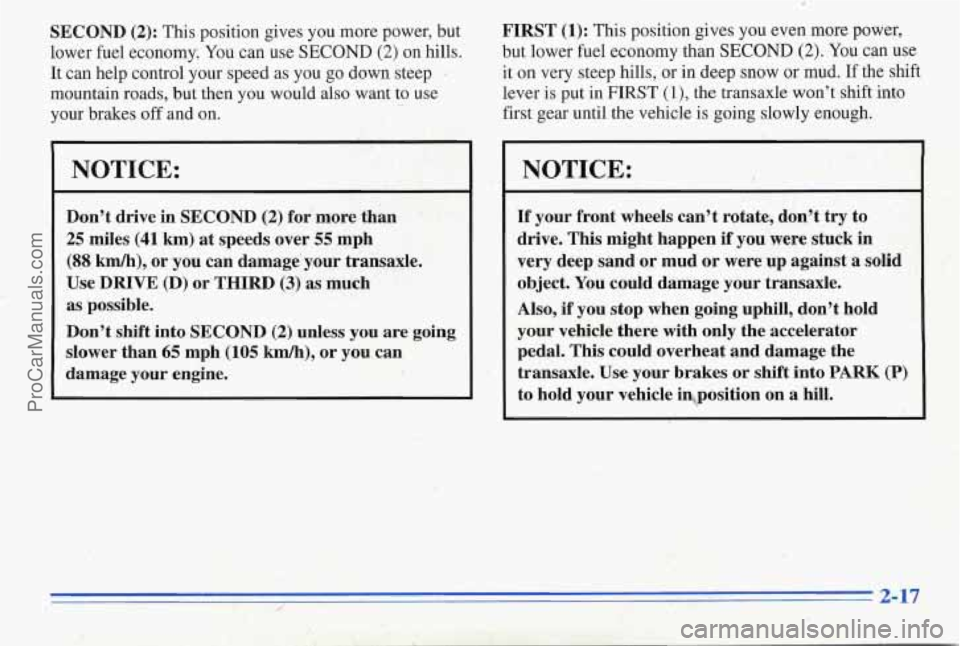
SECOND (2): This position gives you more power, but
lower fuel economy; You can use SECOND
(2) on hills.
It can help control your speed as you
go down steep .
mountain roads, but then you would also want to use
your brakes off and on.
-
NOTICE:
Don’t drive in SECOND (2) for more than
25 miles (41 km) at speeds over 55 mph
(88 km/h), or you can damage’ your transaxle.
Use
DRIVE (D) or THIRD (3) as much
as possible.
Don’t shift into SECOND
(2) unless you are going
slower than
65 mph (105 km/h), or you can
damage
your engine. FIRST
(1): This
position gives you even more power,
but lower fuel economy than SECOND
(2). You can use
it on very steep hills, or in deep snow or mud.
If the shift
lever is put in
FIRST (l), the transaxle won’t shift into
first gear until the vehicle
is going slowly enough.
~
If your front wheels can’t rotate, don’t try to
drive. This might happen
if you were stuck in
very deep sand or mud or were up against a solid
object. You could damage your transaxle.
Also,
if you stop when going uphill, don’t hold
your vehicle there with only the accelerator
pedal. This could overheat and damage the
transaxle. Use your brakes or shift
into PARK (P)
to hold your vehicle iqposition on a hill.
ProCarManuals.com
Page 87 of 370
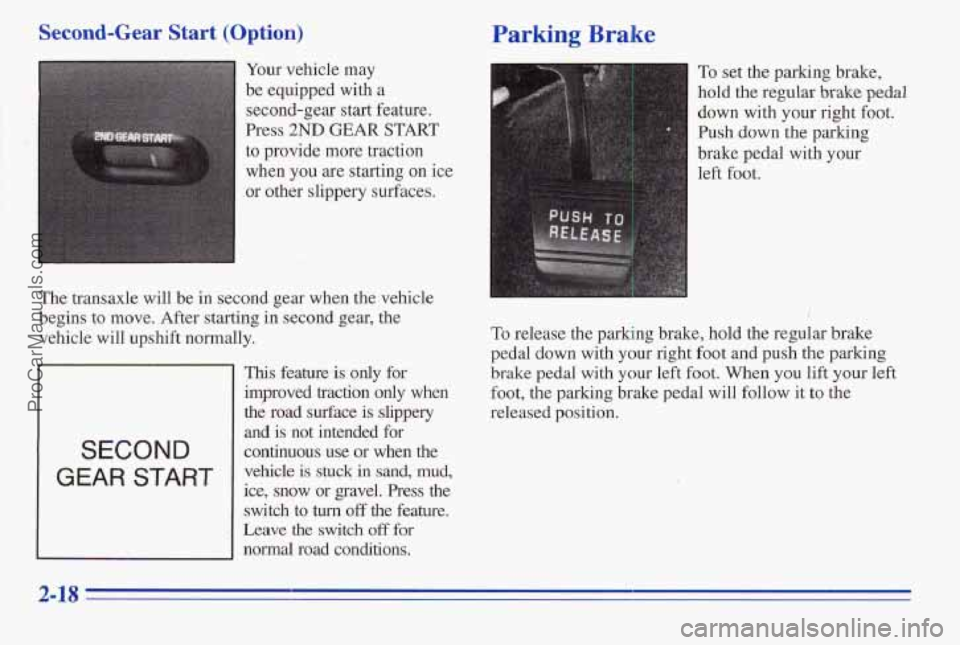
Second-Gear Start (Option) Parking Brake
Your vehicle may
be equipped with a
second-gear start feature.
Press
2ND GEAR START
to provide more traction
when you
are starting on ice
or other slippery surfaces.
The transaxle will be in second gear when the vehicle
begins to move. After starting
in second gear, the
vehicle will upshift normally.
SECOND
GEAR START
his feature is only for
improved traction
only when
the road surface is slippery
and is not intended for
continuous use or when the
vehicle is stuck in sand, .mud,
ice, snow or gravel. Press the
switch to
turn off the feature.
Leave the switch
off for
normal road conditions.
To set the parking brake,
hold the regular
brake pedal
down
with your right foot.
Push down the parking
brake pedal with your
left foot.
To release the parking brake, hold the regular brake
pedal down with your right
foot and push the parking
brake pedal with your left foot.
When you lift your left
foot, the parking brake pedal will follow it to the
released position.
ProCarManuals.com
Page 88 of 370
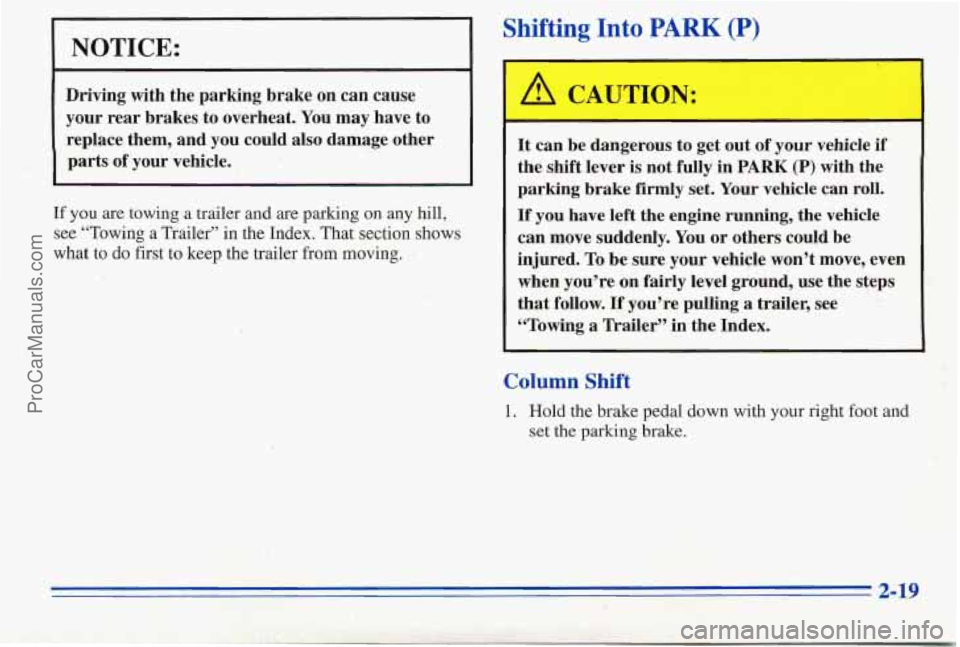
Shifting Into PARK (P)
NOTICE:
Driving with the parking brake on can cause
your rear brakes to overheat. You may have to
replace them, and you could also damage other
parts of your vehicle.
If
you are towing a trailer and are parking on any hill,
see "Towing a Trailer" in the Index. That section shows
what to do first
to keep the trailer from moving.
L
e dangerous to get out of your vehicle if
the shift. lever is not fully in
PARK (P) with the
parking brake firmly
set. Your vehicle can roll.
If you have left the engine running, the vehicle
can move suddenly.
You or others could be
injured.
TO be sure your vehicle won't move, even
when you're on
fairly level ground, use the steps
that follow.
If you're pulling a trailer, see
"Towing a Trailer'' in the Index.
Column Shift
1. Hold the brake pedal down with your right foot and
set the
parking brake.
ProCarManuals.com
Page 89 of 370
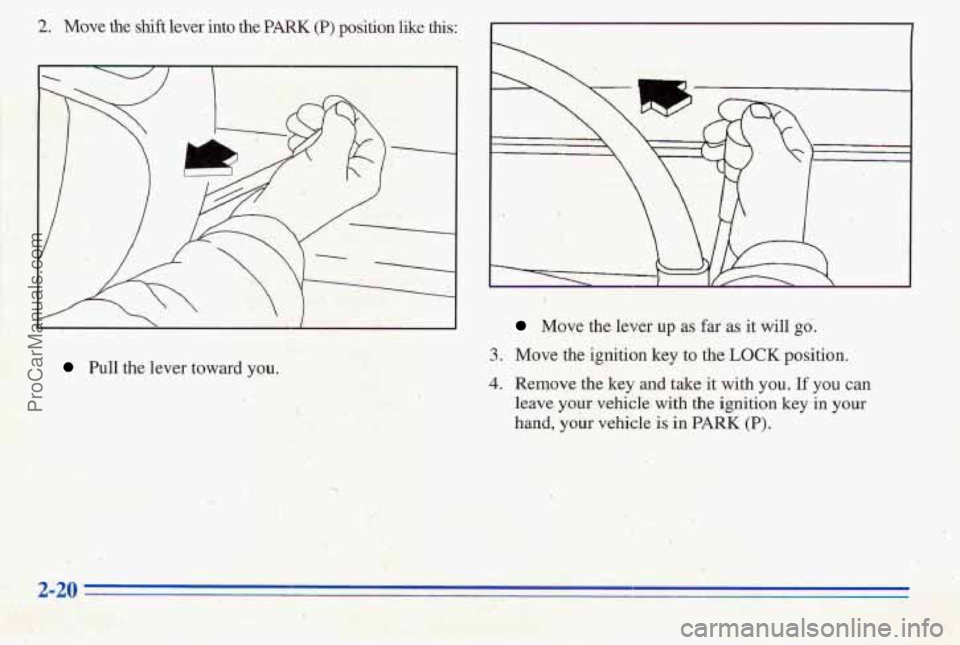
2. Move the shift lever into the PARK (P) position like this:
I' 1
!
Pull the lever toward you..
Move the.lever up as far as it will go.
3. Move the ignition key to the LOCK position.
4. Remove the key and take it with you. If you can
leave your vehicle. with the
ignition key in your
hand, your vehicle is in PARK (P).
ProCarManuals.com
Page 90 of 370
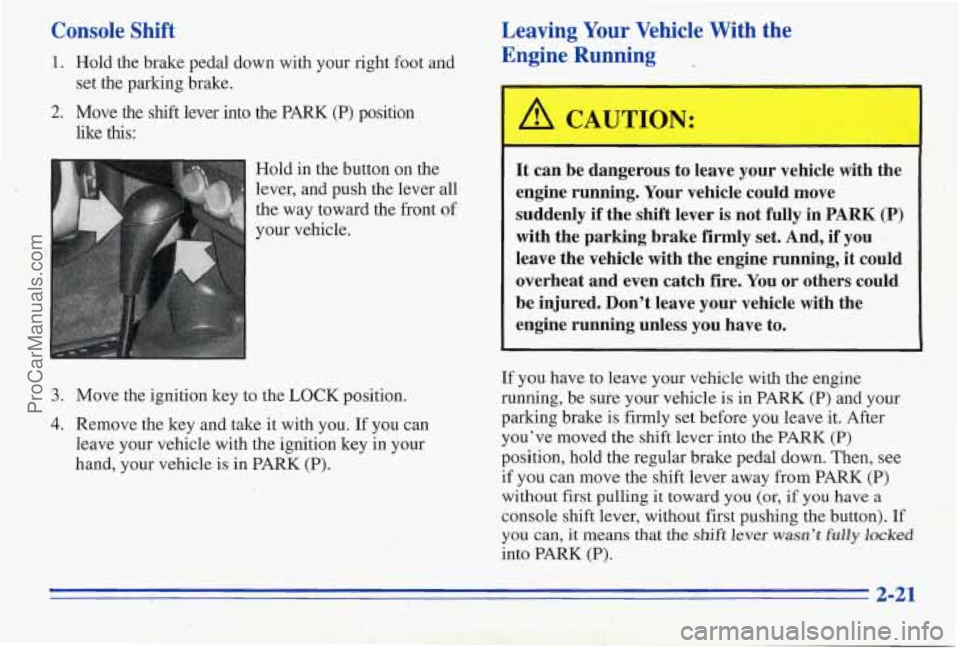
Console Shift
1. Hold the brake pedal down with your right foot and
2. Move the shift lever into the PARK (P) position
set the parking brake.
like
this:
I Hold in the button on the
lever,, and push ‘the lever
all
the way toward the front of
3. Move the ignition key to the ‘LOCK position.
4. Remove the key and take it with you. If you can
leave your vehicle with the ignition
key in your
hand, your vehicle is in PARK (P).
. /. 1 ,‘r ,*
Leaving Your Vehicle With the
Engine Running
A CAUTION:
It can be dangerous to leave your vehicle with the
engine running. Your vehicle could move
suddenly
if the shift lever is not fully in PARK (P)
with the parking brake firmly set. And, if you I
leave the vehicle with the engine running, it could
overheat and even catch fire. You or others could
be injured. Don’t leave your vehicle with the
engine running unless you have to.
If you have to leave your vehicle with the engine
running, be sure your vehicle is in PARK (P) and your
parking brake
is firmly set before you leave it. After
you’ve moved the shift lever into the PARK
(P)
position, hold the regular brake pedal down. Then, see
if you can move the shift lever away from PARK (P)
without
first pulling it toward you (or, if you have a
console shift lever, without first pushing the button). If
you can, it means that the shift lever wasn’t fully locked
into PARK (P) .
2-21
ProCarManuals.com